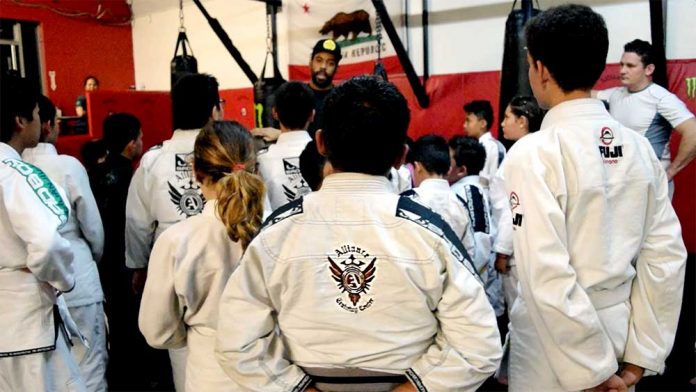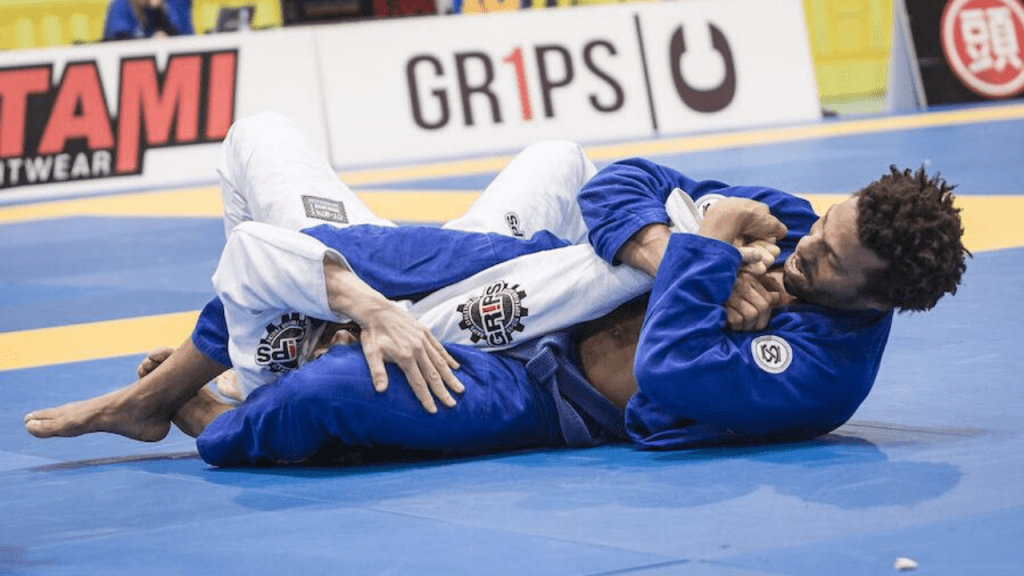
Do you understand the language of Brazilian Jiu-Jitsu? Are you confused by the sheer number of crazy names that come in several different languages, from Japanese to Portuguese? Well, you’re not alone. Jiu-Jitsu is vast, and we like to name things. So, you get plenty of different names for just about everything that happens. Yet, if you are a beginner, you shouldn’t worry too much about all the BJJ talk. Instead, focus on learning the Jiu-Jitsu alphabet first, so that you can converse in the language fluently one yourself.
The concept of the BJJ alphabet is a really cool one. For beginners, it may prove to be the bridge they need to start understanding exactly what older students are talking about most of the time. With that in mind, we connected each letter of the English alphabet to a corresponding BJJ phrase, word, move, etc. in order to help beginners find sense in the Gentle Art. It may turn out to help even older students though.
How To Talk The BJJ Talk
It often happens at BJJ seminars, or camps, that people can’t talk to each other because of language barriers. And still, they can train together, they understand what’s going on at the seminar and can communicate perfectly through BJJ. Jiu-Jitsu is a language in itself, one that helps people who know it has some of the most meaningful “conversations” they will ever have.
And still, if we take a look at the more practical side of Jiu-Jitsu as a language, you’ll see that there’s too much stuff in there to be able to categorize in any meaningful way. The freedom of BJJJ allows people to constantly name things in ways that make sense to them. While at a gym level that’s not a big deal, for those that have a huge influence on the sport, coming out with original nomenclature can have worldwide consequences. Just look at Eddie Bravo as the perfect example. Half the time nobody knows what 10th Planet Jiu-Jitsu folks are talking about, with everything having its own (weird and funny) name.
The same holds true for others, like Danaher for example. He just likes to use old-school Japanese terms much more than crazy names that make people laugh. As BJJ evolves, people keep adding to the language, both in terms of moves and names that correspond with them. However, just like any other language, BJJ talk is based on some common foundations. Those are the letters of the BJJ alphabet. And, since it is really hard to categorize BJJ in any sort of way, we took the alphabet format to try and make things make more sense for people that are just starting out in the art.
The Brazilian Jiu-Jitsu Alphabet For Beginners
What exactly is the BJ Jalhpabet? Who knows. It may be different for everyone out there. However, in terms of the alphabet we all know and use every day, we can offer you 26 BJJ talk phrases and terms, that will help you understand just what is happening on those mats. After all, you only need the basics – you’ll start speaking Jiu-Jitsu in a short time for yourself, and you’ll be able to understand literally every grappler in the world.
A: Armbar

B: Bridge
A fundamental BJJ motion that you’ll hear about over and over again. From having it explained in training to having it shouted at you while you’re competing. One of the three fundamental defensive BJJ movements, you’ll be bridging in every direction as long as you train Jiu-Jitsu.
C: Choke
One of the most used words in BJJ talk. It refers to every submission that attacks the neck, whether it is done with just your hands, or using the collars and lapels of the Gi. The best and ultimate way of winning a match, with the rear-naked choke being the one you’ll hear about the most (probably).
D: Defense
Absolutely necessary. How do you approach Jiu-Jitsu in a smart way? Learn to defend every position, before you learn to attack from them. Easy. Thinking about defense will make you better at offense too because you’ll know the walls you need to tear down in order to get that choke or armbar.
E: Enjoy
The one thing everyone should do is enjoy Jiu-Jitsu. The moment you walk through the academy doors, it should all be about positive experiences and enjoyment. Have fun, find satisfaction in everything, from tapping people out to tapping out yourself.
F: Fail
You’ll often hear instructors and more experienced belts talk about failing. One thing is for certain, you will fail with plenty of things you give a try in BJJ. That’s how you get better at it. The lessons failure brings about are some of the bet you’ll learn in Brazilian JIu-Jitsu and life.
G: Grips

H: Hips
Try doing any physical activity without engaging your hips. You can’t, right? Hips in Jiu-Jitsu have the most crucial role of all – to help you move through space. Hip escapes, hip heists, hip switching, stand-ups, hip pressure… the list goes on and on. Be mindful of your hips and what they’re doing at all times.
I: Invent
The one thing about Jiu-Jitsu that I probably love the most (along with rolling, of course). Unlike traditional martial arts, BJJ encourages people to invent things and constantly move the borders on what can and can not be done.
J: Ju-Jitsu
A tribute to the origins of the art. Japanese Ju-Jitsu, the art of the Samurai is what gave birth to the BJJ we train today. Of course, it was Judo first, and then Gracie Jiu-Jitsu / BJJ, but it all started with Ju-Jitsu. Some Japanese terms are still a big part of BJJ talk, like Kimura. For example.
K: Kneebar
One of the best joint locks you can do in Jiu-Jitsu. The kneebar is akin to the armbar, just done on the leg. It is a move you can do in all sorts of competitions, In some, though, you’ll have to wait until you’re at a more advanced belt level until you’re allowed. However, it is never too early to start learning kneebars, so you might as well start now.
L: Lifestyle
As you’ll soon figure out, BJJ is more than a sport or martial art. It is an entire lifestyle that almost everyone who gets into the art adopts. Jiu-Jitsu will take over your life even before you learn all the BJJ talk, and you’ll soon look, talk, walk and live the act. And it is going to be the best thing that has happened to you.
M: Movement
This is a simple word but it holds within the essence of Jiu-Jitsu. In order to accomplish anything in BJJ, you need movement. However, you do not just need to move around You either need specific movement, or you need no movement at all. Once you understand which fits where Jiu-Jitsu will open up crazy new perspectives for you.
N: Neck
Protect it, attack it, control it, bend it, crank it. There are so many things you can do with the neck in Jiu-Jitsu, regardless if it si you own, or that of your opponent. If the hips are the driving force of everything in Jiu-Jitsu, the neck is the target you need to protect or look for at all times.
O: Open Mat
A concept that’s I think specific to BJJ. There’s one at least once a week in every academy in the world. It is a time when the gym is open for you to do whatever you want. While people have the option of drilling, stretching, or doing whatever an open mat is a synonym for having a lot of time to do as many rolls as you can.
P: Position Sparring
Contrary to all-out sparring, positional sparring is one of the best tools to help you learn Jiu-Jitsu better and in less time. The concept is that you should spend some time training every position you learn, with a partner trying to resist you. These should be at the end of every class but are often times skipped in favor of all-out sparring.
Q: Question everything
This ties in with Innovation. BJJ is highly individual, and your own character needs to shine through in order tor you to build a functional Jiu-Jitsu game. Whenever you need to ask something of your instructors, or training partners, do it! Questioning things is how the art came to be, and it is how it is going to keep moving forward constantly. Ask things!
R: Roll

S: Submissions
What exactly is a submission? It is every move that will cause an opponent to surrender. In Jiu-jitsu, those are joint locks on the extremities, whether it is arms or legs, and all the attacks on the neck. While they are mostly chokes and strangles, you could also attack joint lock on the neck as well. Those are the moves everyone hunts for, which also makes them the moves that are the hardest to achieve.
T: Tap
Tapping is what you do when you’re caught in a submission. The moment you feel you’re in discomfort, or you know you’ve been caught, you tap. Tapping means slapping two-three times on the mats or on your opponent’s body. Remember that you should tap early and often if you want to prevent needless injuries.
U: Uniform
The BJJ uniform nowadays comes in two different versions. One is the Gi or Kimono, similar to that of other martial arts, but still unique. BJJ Gis feature specific characteristics and come in different shapes and sizes. You could also train BJJ without a kimono, which in BJJ talk is referred to as No-Gi. That means you’re wearing a t-shirt and shorts, or rashguards and spats for training. Going No-Gi completely changes the intensity, grip fighting and many other aspects of the game.
V: Videos
It is a modern world and BJJ is adoptable if nothing else. Given the amount of information available in video format, why not learn Jiu-JItsu that way? Anything, from Youtube videos to full-blown instructional BJJ DVDs is a great tool for sharpening up your game. The choices out there are endless.
W: Warm-up
The one part of training everyone wants to skip but shouldn’t. Usually, Jiu-Jitsu warm-ups are different from your usual physical activity ones. However, they can get monotonous and boring if instructors don’t switch them up from time to time.
X: X-guard(s)
A position that is fundamental in the modern BJJ game. The X guard has several variations and you can expect to spend a lot of time trying to figure it out both form top and bottom. It is a variation of open guard and you absolutely need it in your arsenal. The more variations you can master, the better.
Y: Yoga
The perfect compliment to Brazilian Jiu-Jitsu. In fact, plenty of gyms have regular yoga classes, and might even have short routines as part of warm-ups or cool-downs. Simply put, yoga helps your body get back in order after all the fun abuse it has to go through while rolling and practicing JIu-Jitsu. Highly recommended.
Z: Z-guard
Another guard that you’ll have to figure out at one point or another. The Z Guard is just BJJ talk for placing a knee between you and your opponent when you’re on the ground, in order to keep them away from you. While playing it is not quite so easy, understanding what this guard is about is not more complicated than this explanation.
Closing Arguments
You’ll learn how to talk Jiu-Jitsu on your own. That’s inevitable. However, you can start exploring all the BJJ talk by using the BJJ alphabet we put together in order to spend less time trying to figure out what things mean. Once you have all the letters down, you ‘ll soon be able to start making words and putting sentences together. They’ll be no shutting you up afterward!












































